Fiber Reinforced Polymer Composite Rebar (FRP Rebar) Market Research, 2032
The global FRP composite rebar Market market was valued at $654.5 million in 2022, and is projected to reach $1.8 billion by 2032, growing at a CAGR of 10.6% from 2023 to 2032. Fiber Reinforced Polymer (FRP) rebar is an innovative construction materials, presenting a resilient and corrosion-resistant alternative to traditional steel reinforcement. Comprising high-strength fibers, such as glass or carbon, embedded in a polymer matrix, primarily epoxy resin, this advanced composite material addresses numerous challenges associated with steel reinforcement in various construction applications. The primary advantage of FRP rebar is its corrosion resistance. In contrast to steel, which is prone to corrosion, especially in harsh environments, FRP rebar remains impervious to rust and other forms of deterioration. This characteristic significantly extends the lifespan of reinforced concrete structures, simultaneously reducing maintenance costs and enhancing structural integrity. Consequently, the corrosion-resistant nature of FRP rebar is particularly suitable for infrastructure projects in coastal areas or regions prone to aggressive environmental conditions.
Highlights of the Report
- The report provides exclusive and comprehensive analysis of the global FRP rebar market trends along with the FRP rebar market forecast.
- The report elucidates the FRP rebar market opportunity along with key drivers, and restraints of the market. It is a compilation of detailed information, inputs from industry participants and industry experts across the value chain, and quantitative and qualitative assessment by industry analysts.
- Porter’s five forces analysis helps analyze the potential of the buyers & suppliers and the competitive scenario of the market for strategy building.
- The report entailing the FRP rebar market analysis maps the qualitative sway of various industry factors on market segments as well as geographies.
- The data in this report aims on market dynamics, trends, and developments affecting the FRP rebar market growth.
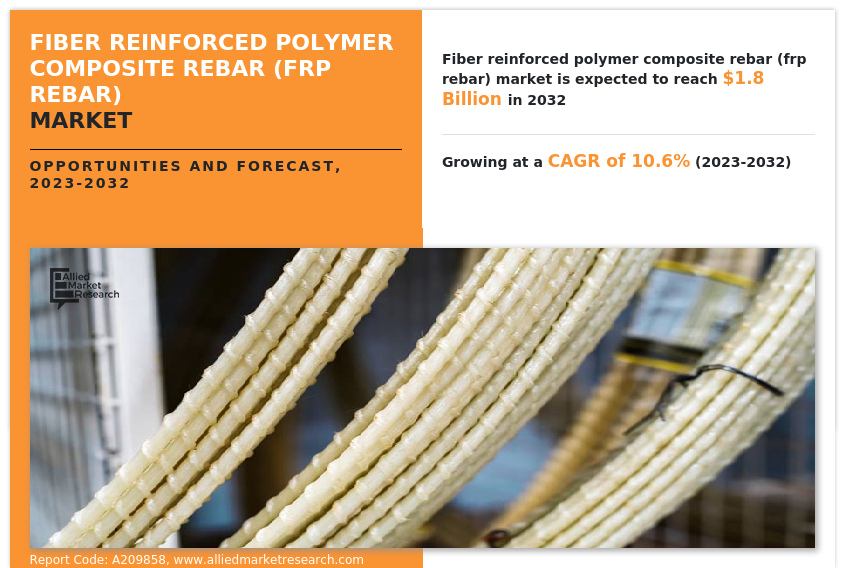
The fibers employed in the composition of FRP rebar, such as glass or carbon, contribute to its impressive strength-to-weight ratio. This distinctive feature not only streamlines transportation and installation processes but also positions FRP rebar as an optimal choice for applications where weight reduction is crucial. The lightweight nature of FRP rebar proves advantageous, particularly in seismic-prone regions where minimizing the overall mass of a structure is a pivotal consideration.
The global surge in infrastructural development projects has sparked a significant transformation in construction practices, with a noteworthy shift towards the adoption of fiber reinforced polymer (FRP) rebar. This alternative to traditional steel reinforcement in concrete structures is gaining prominence due to its combination of strength, corrosion resistance, and lightweight properties. The demand for FRP composite rebar market is growing due to rising awareness of its benefits compared to steel. Traditional steel reinforcement is often impacted by issues such as corrosion and substantial weight, resulting in a search for more durable and durable construction materials. FRP rebar addresses these concerns effectively, offering resilience against corrosive elements and reducing overall weight in structures. In addition, governments and private investors are increasingly acknowledging the long-term advantages associated with incorporating FRP rebar in construction projects. Its ability to withstand harsh environmental conditions ensures the longevity and structural integrity of the building structure.
The construction industry faces a notable challenge in the adoption of fiber reinforced polymer composite rebar (FRP Rebar) market forecast due to the persistently high cost of the rebar, particularly the glass fiber-reinforced polymer (GFRP) variant. Despite a downward trend in GFRP costs, it remains pricier than traditional steel reinforcement. This cost disparity poses a significant constraint for contractors and engineers aiming to minimize construction expenses, leading several decision-makers to prioritize economically favorable steel reinforcement during project planning. However, it is essential to recognize that the cost of GFRP rebar is accompanied by substantial long-term benefits.
The construction industry is witnessing a significant surge in the adoption of fiber reinforced polymer composite rebar (FRP Rebar) industry, particularly in seismic zones, where tectonic activity poses a constant threat to traditional construction materials. These seismic zones are prone to earthquakes, making it necessary to explore alternative materials that offer heightened structural resilience. FRP rebar emerges as a promising solution due to its properties, including superior strength, durability, and corrosion resistance. These attributes make FRP rebar an ideal choice for construction in seismic zones, where the demand for resilient and earthquake-resistant structures is critical. The inherent characteristics of FRP rebar contribute significantly to enhanced structural integrity, effectively reducing the risk of damage during seismic events. Therefore, the adoption of fiber reinforced polymer composite rebar (FRP Rebar) market size is expected to increase, particularly in disaster-prone infrastructure, as they play a pivotal role in improving overall safety and fortifying buildings and infrastructure against the impact of seismic activity.
Competitive Landscape:
The key players profiled in this report are Hughes Brothers Inc, Marshall Composite Technologies LLC, Kodiak Fiberglass Rebar LLC, International Grating Inc., BP Composites Ltd., Pultron Composites, Dextra Group, Owens Corning, Exel Composites, and FiReP Group. Acquisition, product launch, and strategic partnership are common strategies followed by major market players. For instance, in January 2024, GatorBar, a composite rebar manufacturer specializing in concrete reinforcement, announced its latest innovation GatorBar Grip technology. This advancement enhances the existing GatorBar by introducing features such as zero slivers and increased bond strength. The newly launched GatorBar Grip is readily accessible through the company's wholesale, distribution, and installation partners. Maintaining the reliability of the original GatorBar, the Grip technology introduces significant improvements in handling and tying characteristics, along with a substantial boost in bond strength. This development highlights GatorBar's commitment toward advancing concrete reinforcement technology while ensuring cost-effectiveness and adherence to ICC structural requirements. GatorBar is a non-polyester glass fiber-reinforced composite rebar (GFRP), manufactured in the U.S. The company declared that its pricing is competitive, if not better than steel, offering increased strength and performance. Noteworthy advantages include enhanced installation efficiency, reduced labor requirements, and improved transportation logistics. GatorBar is expected to be twice as strong in tensile strength and four times lighter than traditional steel, positioning it as a durable and efficient alternative in the state of composite rebar for concrete reinforcement.
Segment Overview:
The FRP composite rebar market analysis is segmented on the basis of fiber type, resin type, application, and region. By fiber type the market is divided into glass fiber, aramid fiber, basalt fiber, carbon fiber, and others. By resin type the market is classified into vinyl ester, epoxy, and others. By application, the market is classified into highways, bridges & buildings, marine infrastructures, water treatment facilities, and others. By region, the market is analyzed across North America, Europe, Asia-Pacific, and LAMEA.
The fiber reinforced polymer composite rebar (frp rebar) market is segmented into Resin Type, Fiber Type and Application.
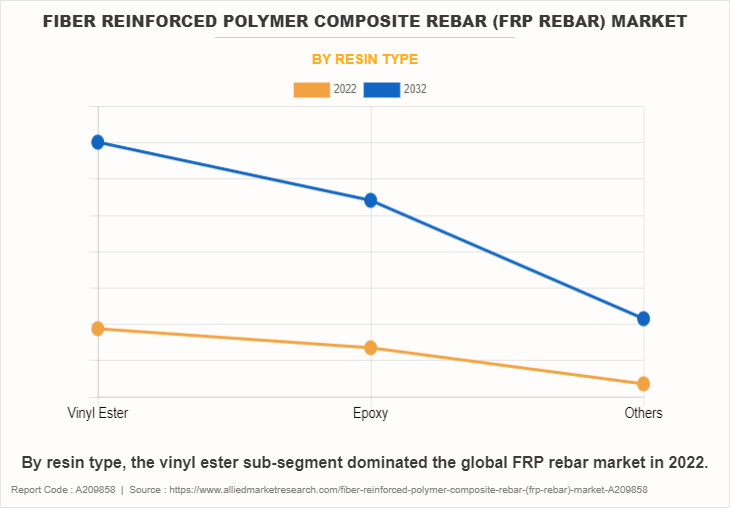
By resin type, the vinyl ester sub-segment dominated the global FRP rebar market in 2022. The vinyl ester sub-segment growth reflects its widespread adoption and versatility in various applications within the FRP rebar industry. This resin type demand is attributed to its mechanical properties, including high strength, corrosion resistance, and durability, making it an ideal choice for reinforcing structures. Vinyl ester resin's superior performance characteristics contribute significantly to the overall market growth and position it as a preferred material for construction applications, particularly in corrosive environments. As the construction industry increasingly seeks durable and corrosion-resistant solutions, the vinyl ester sub-segment continues to gain traction, marking its leading position in the global FRP composite rebar market growth.
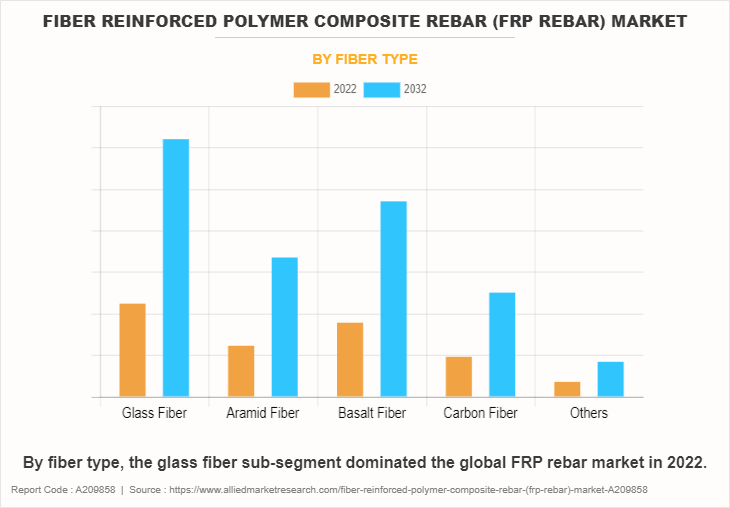
By fiber type, the glass fiber sub-segment dominated the global fiber reinforced polymer composite rebar (FRP Rebar) market share in 2022. The market dynamics indicate a substantial shift towards the widespread adoption of glass fiber as a primary reinforcing material. This trend can be attributed to the unique properties of glass fiber, including high tensile strength, corrosion resistance, and durability. The increase in demand for FRP rebar, a key component in construction and infrastructure projects, highlights the significance of glass fiber in the market. The dominance of glass fiber in FRP rebar reflects its ability to address the challenges associated with traditional reinforcement materials like steel. Glass fiber's lightweight nature and resistance to corrosion make it an attractive choice for enhancing the life and structural integrity of various concrete applications.
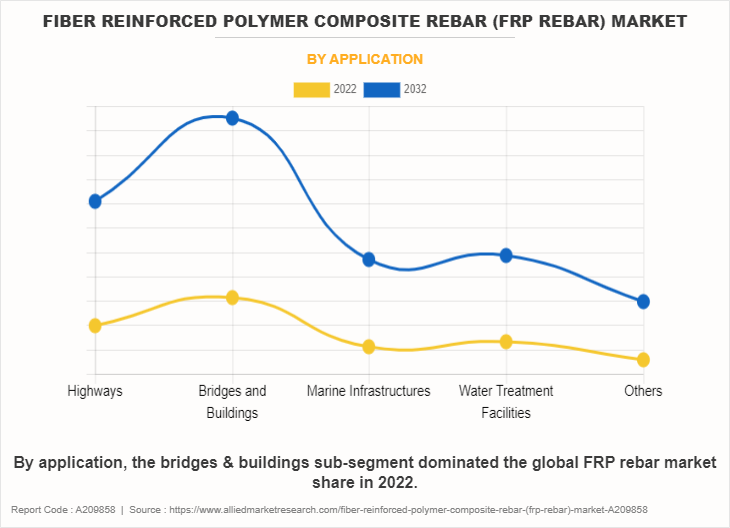
By application, the bridges & buildings sub-segment dominated the global FRP rebar market share in 2022. This dominance can be attributed to the extensive application of FRP rebar in the construction of bridges and buildings worldwide. As a structural reinforcement material, FRP rebar offers superior characteristics such as high strength, corrosion resistance, and lightweight properties. These attributes make it a preferred choice in the construction industry, particularly for infrastructure projects like bridges and buildings. The demand for FRP rebars in the bridges and buildings sector is driven by the need for durable and long-lasting structures, where traditional steel reinforcement may be susceptible to corrosion and deterioration over time. FRP rebar addresses these concerns, providing a solution for enhanced structural integrity and longevity. The widespread adoption of FRP rebar in this sub-segment highlights its significance in modern construction practices, contributing to the overall growth and dominance of the material in the global market for structural reinforcement applications.
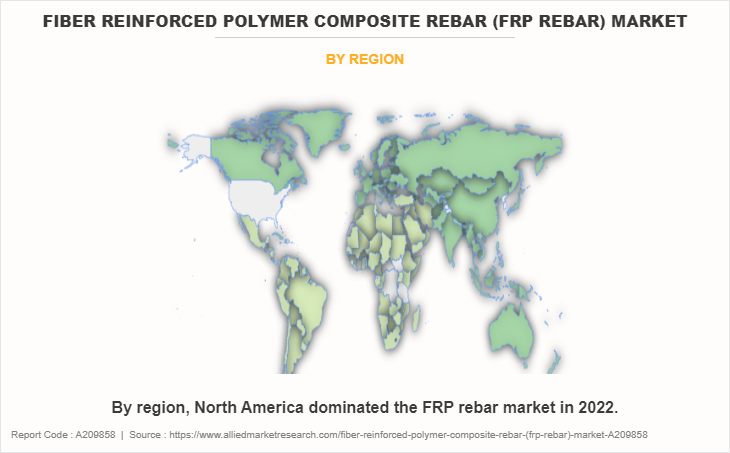
By region, North America dominated the FRP rebar market in 2022. The region's dominant position is highlighted by its leadership in the utilization and demand for FRP rebar products. This market dominance in North America is indicative of the region's strategic significance and influence in shaping the trajectory of FRP rebar trends. The dominance of North America in the FRP rebar market can be attributed to factors such as technological advancements, infrastructure development, and a growing recognition of the benefits offered by FRP rebar in construction applications. The region's enduring commitment toward innovation and adherence to modern construction practices have led to its leading position in the global FRP rebar landscape.
Key Benefits For Stakeholders
- This report provides a quantitative analysis of the market segments, current trends, estimations, and dynamics of the fiber reinforced polymer composite rebar (frp rebar) market analysis from 2022 to 2032 to identify the prevailing fiber reinforced polymer composite rebar (frp rebar) market opportunities.
- The market research is offered along with information related to key drivers, restraints, and opportunities.
- Porter's five forces analysis highlights the potency of buyers and suppliers to enable stakeholders make profit-oriented business decisions and strengthen their supplier-buyer network.
- In-depth analysis of the fiber reinforced polymer composite rebar (frp rebar) market segmentation assists to determine the prevailing market opportunities.
- Major countries in each region are mapped according to their revenue contribution to the global market.
- Market player positioning facilitates benchmarking and provides a clear understanding of the present position of the market players.
- The report includes the analysis of the regional as well as global fiber reinforced polymer composite rebar (frp rebar) market trends, key players, market segments, application areas, and market growth strategies.
Fiber Reinforced Polymer Composite Rebar (FRP Rebar) Market Report Highlights
| Aspects | Details |
| Market Size By 2032 | USD 1.8 billion |
| Growth Rate | CAGR of 10.6% |
| Forecast period | 2022 - 2032 |
| Report Pages | 298 |
| By Resin Type |
|
| By Fiber Type |
|
| By Application |
|
| By Region |
|
| Key Market Players | exel composites, pultron composites ltd, dextra group plc, Owens Corning, Kodiak Fiberglass Rebar LLC, FiReP Group, Marshall Composite Technologies LLC, BP Composites Ltd., International Grating Inc., Hughes Brothers Inc |
The FRP rebar market size is expected to grow due to an increase in infrastructural development projects globally.
The major growth strategies adopted by the FRP rebar market players are product launches and partnership & agreements.
Asia-Pacific will provide more business opportunities for the global FRP rebar market in the future.
Hughes Brothers Inc, Marshall Composite Technologies LLC, Kodiak Fiberglass Rebar LLC, International Grating Inc., BP Composites Ltd., Pultron Composites, Dextra Group, Owens Corning, Exel Composites, and FiReP Group are the major players in the FRP rebar market.
The glass fiber sub-segment of the fiber type acquired the maximum share of the global FRP rebar market in 2022.
Construction companies are the major customers in the global FRP rebar market.
The report provides an extensive qualitative and quantitative analysis of the current trends and future estimations of the global FRP rebar market from 2022 to 2032 to determine the prevailing opportunities.
The increasing construction of bridges and buildings across the globe is expected to drive the adoption of FRP rebar.
The rising adoption of sustainable construction products in construction applications is expected to influence the market during the forecast period.
Loading Table Of Content...
Loading Research Methodology...



